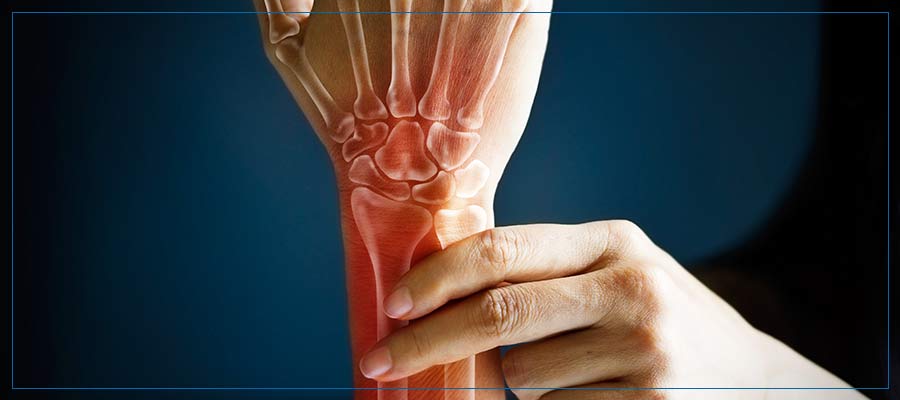Urgent Care for Acute Fracture Treatment in Fairfax, VA
Fractures can occur from accidents, falls, or trauma, leading to pain and limited mobility. At Prima Urgent Care, our medical team effectively treats fractures, focusing on pain relief, stabilization, and promoting recovery. We are committed to offering the right care to help you heal quickly and return to your regular activities. For more information, contact us or schedule an appointment today. We are conveniently located at 3903 Fair Ridge Dr Suite Q, Fairfax, VA 22033.


Table of Contents:
What is considered an acute fracture?
What are the symptoms of an acute fracture?
Can urgent care treat fractures?
What follow-up care is recommended after initial treatment for an acute fracture at urgent care?
An acute fracture, a distinct type of bone breakage, arises from a specific traumatic event, such as a thunderous fall, a forceful impact, an unforgiving collision, or an intense sports-related incident. This sudden disruption in the bone’s continuity manifests with immediate symptoms, including excruciating pain, relentless swelling, and a significant reduction in the affected limb’s mobility.
The diagnosis of an acute fracture commences with a meticulous physical examination. To further elucidate the extent of the injury, medical professionals utilize sophisticated imaging techniques such as X-rays, computed tomography (CT) scans, or magnetic resonance imaging (MRI). These modalities provide detailed visual representations of the injured area, enabling precise identification of the fracture’s location and severity.
• Abrupt Initiation: The fracture manifests instantaneously, usually with a clear-cut cause that can be easily pinpointed.
• Swift Symptom Onset: Excruciating pain, relentless swelling, visible bruising, and sometimes a noticeable deformity emerges swiftly after the traumatic event.
• Functional Inhibition: A profound loss of function is typically associated with an acute fracture, such as an inability to move the affected limb or an inability to bear weight.
While its presentation may vary depending on the affected bone and the extent of the injury, certain telltale indicators can help recognize this medical emergency:
Cardinal Symptoms:
Intense, Abrupt Pain:
• Immediate, piercing discomfort localized to the fracture site.
• Exacerbated by movement or external pressure, indicating tissue damage.
Rapid Swelling (Edema):
• A swift onset of swelling around the injured area.
• Triggered by inflammation and blood seepage into surrounding tissues.
• Can manifest within minutes to hours post-injury.
Bruising (Ecchymosis):
• Discoloration of the skin surrounding the fracture site.
• Resulting from subcutaneous bleeding due to ruptured blood vessels.
• Typically appears within a few hours to several days.
Physical Manifestations:
Deformity:
• A noticeable change in the shape or alignment of the affected limb or joint.
• The affected area may appear misaligned or distorted.
• May be subtle or pronounced, depending on the fracture pattern.
Functional Impairment:
• Difficulty or inability to use the injured limb or body part.
• Movement may be severely restricted or rendered impossible due to the compromised bone structure.
Crepitus Sensation:
• A grating sensation or sound perceived when the broken bone fragments move against each other.
• Arises from the contact of jagged bone edges.
Tenderness:
• Extreme pain upon gentle touch or movement of the affected area.
• The fracture site is highly sensitive due to the disruption of surrounding nerve endings.
Reduced Mobility:
• A noticeable decrease in the range of motion in the injured area.
• Limitations are caused by pain, swelling, or mechanical obstruction by the fractured bone.
Neurological Complications (if present):
• Neurological Symptoms:
• Numbness or tingling sensations in the affected area.
• Muscle weakness or paralysis.
• Loss of sensation in the injured limb or body part.
• These symptoms indicate potential nerve damage or impingement.
Additional Critical Signs:
• Open Fracture:
The protrusion of bone fragments through the skin, creating a high risk of infection and further complications.
• Excessive Bleeding:
Can lead to symptoms like dizziness or fainting due to significant blood loss.
• Respiratory Difficulties:
Fractures in the chest area can impair breathing by hindering respiratory movements.
Immediate medical attention is paramount if an acute fracture is suspected. Healthcare professionals will typically employ imaging techniques, such as X-rays or CT scans, to confirm the fracture and guide the most appropriate treatment plan.
Fractures, unfortunately, are a common occurrence. Urgent care centers are adept at handling a spectrum of fractures, particularly those that fall within the minor to moderate range. With state-of-the-art diagnostic tools like X-ray machines, they can accurately pinpoint the location and extent of the fracture. Based on the findings, urgent care professionals can provide prompt treatment options, such as splinting or casting, to immobilize the injured area and promote healing.
Common fractures that urgent care centers frequently address include:
• Finger and toe fractures
• Wrist fractures
• Ankle fractures
• Simple rib fractures without displacement
While urgent care centers are equipped to address minor to moderate fractures, they can also provide initial management for more severe ones, including:
• Hip fractures
• Pelvic fractures
• Femur fractures
• Tibia fractures
However, it’s crucial to understand that surgical intervention is often necessary for complex fractures, and this is generally beyond the purview of urgent care facilities. In these instances, you will be referred to a hospital emergency department or a specialized orthopedic surgeon. Urgent care centers do not typically possess the specialized equipment or expertise required for surgical treatment or advanced orthopedic care that complex fractures demand.
Determining the severity of a fracture can be challenging, especially if you lack medical training. If you’re uncertain about the extent of the injury, it’s always advisable to contact an urgent care center or consult a healthcare professional via telemedicine services. This will ensure you receive the appropriate level of care, whether it’s immediate immobilization or further evaluation at a higher-level facility.
Your recent visit to urgent care for an acute fracture marked the initiation of your healing process. To guarantee optimal outcomes and prevent setbacks, meticulous follow-up care is paramount. Embrace the following recommendations, tailored specifically to your unique recovery journey:
Immediate Post-Visit Care:
Immobilization and Elevation:
• Maintain the provided splint, cast, or brace to immobilize the fractured area.
• Elevate your injured limb above your heart to minimize swelling.
• Cool the injury with ice packs in 20-minute intervals throughout the day.
Pain Management:
• Adhere to the prescribed pain medications or utilize over-the-counter analgesics as directed.
• Continue using ice packs to reduce swelling and alleviate discomfort.
Scheduled Follow-Ups:
Timely Appointments:
• Secure a follow-up visit with an orthopedic specialist or your primary physician within 1-2 weeks.
• These appointments are crucial for evaluating fracture healing and adjusting care as needed.
Re-Examinations and Diagnostics:
• Expect your healthcare provider to re-examine the injured limb and order additional X-rays or imaging to assess alignment and healing progress.
• Adjustments to your immobilization device may be necessary based on these assessments.
Ongoing Care and Monitoring:
Cast and Wound Care:
• Preserve the cast’s integrity by keeping it dry and clean.
• Regularly monitor the skin around the cast for irritation or pressure sores.
• Follow wound care instructions meticulously if there are associated wounds.
Physical Therapy:
• Engage in physical therapy as recommended to restore mobility, strength, and functionality to the affected area.
• Physical therapy typically commences after removing the immobilization device and upon your doctor’s approval.
Activity and Weight-Bearing:
• Comply with your healthcare provider’s guidelines regarding weight-bearing and activity.
• Utilize mobility aids such as crutches or walkers for lower extremity fractures.
• Gradually resume normal activities while avoiding high-impact exercises until your doctor confirms full healing.
Monitoring for Complications:
Warning Signals:
• Vigilantly monitor for signs of infection, compartment syndrome, or other complications, such as increased pain, swelling, redness, fever, numbness, or tingling.
• Seek immediate medical attention if any of these symptoms emerge.
Remember, these recommendations serve as general guidelines. Your healthcare provider will tailor specific instructions based on your fracture severity, location, and overall health. Adhering to these personalized directives will optimize your recovery and ensure a swift return to full functionality.
Don’t let a fracture slow you down. At Prima Urgent Care, we prioritize your health and recovery, offering top-notch care for acute fractures without the long wait times. Our dedicated team is here to support you every step of the way. Visit us today for immediate treatment and to experience the quality care you deserve. Prima Urgent Care – your reliable partner in health and healing. We serve patients from Fairfax VA, South Riding VA, Dulles VA, Chantilly VA, Stone Ridge VA, Oakton VA, Burke VA, Oak Hill VA, Lees Corner VA and beyond!

Check Out Our 5 Star Reviews


Additional Services You May Like

Additional Services You May Like
- Urgent Care
- COVID Testing
- Lab Testing
- X-Rays
- Illness
- Injuries
- Immediate Care
- Employment Physicals
- Allergies
- Flu
- Fever
- Broken Bones
- Kidney Stones
- Hormone Replacement
- DOT Physical Exams
- Drug Testing
- Gonorrhea
- Sports Physicals
- School Physicals
- Sexual Infection
- Vomiting
- Erectile Dysfunction (ED) Treatment
- Vaginal Infection
- Abscesses Skin Infections
- Acute Fracture
- Ankle Sprain
- Back Pain
- Bladder Infection
- Ear Infection
- Eye Infections Styes
- Hemorrhoids
- Knee Sprain
- IV Therapy
- Immigration Physicals
- Minor Dislocation
- Neuropathy Treatments
- Psychiatric Services (Depression/Anxiety)
- Shoulder Pain
- Sinus Infections
- Stomach Flu (Gastroenteritis)
- Strep and Sore Throat
- Auto-Accidents
- Vision Testing
- Pre Op Physicals
- Medical Weight Loss
- More Services







